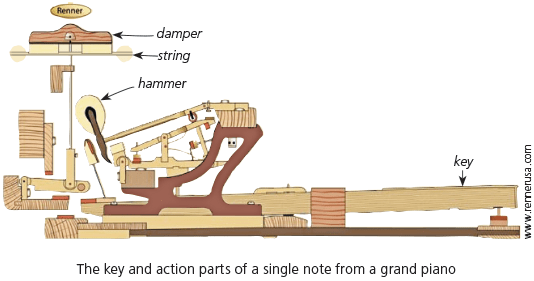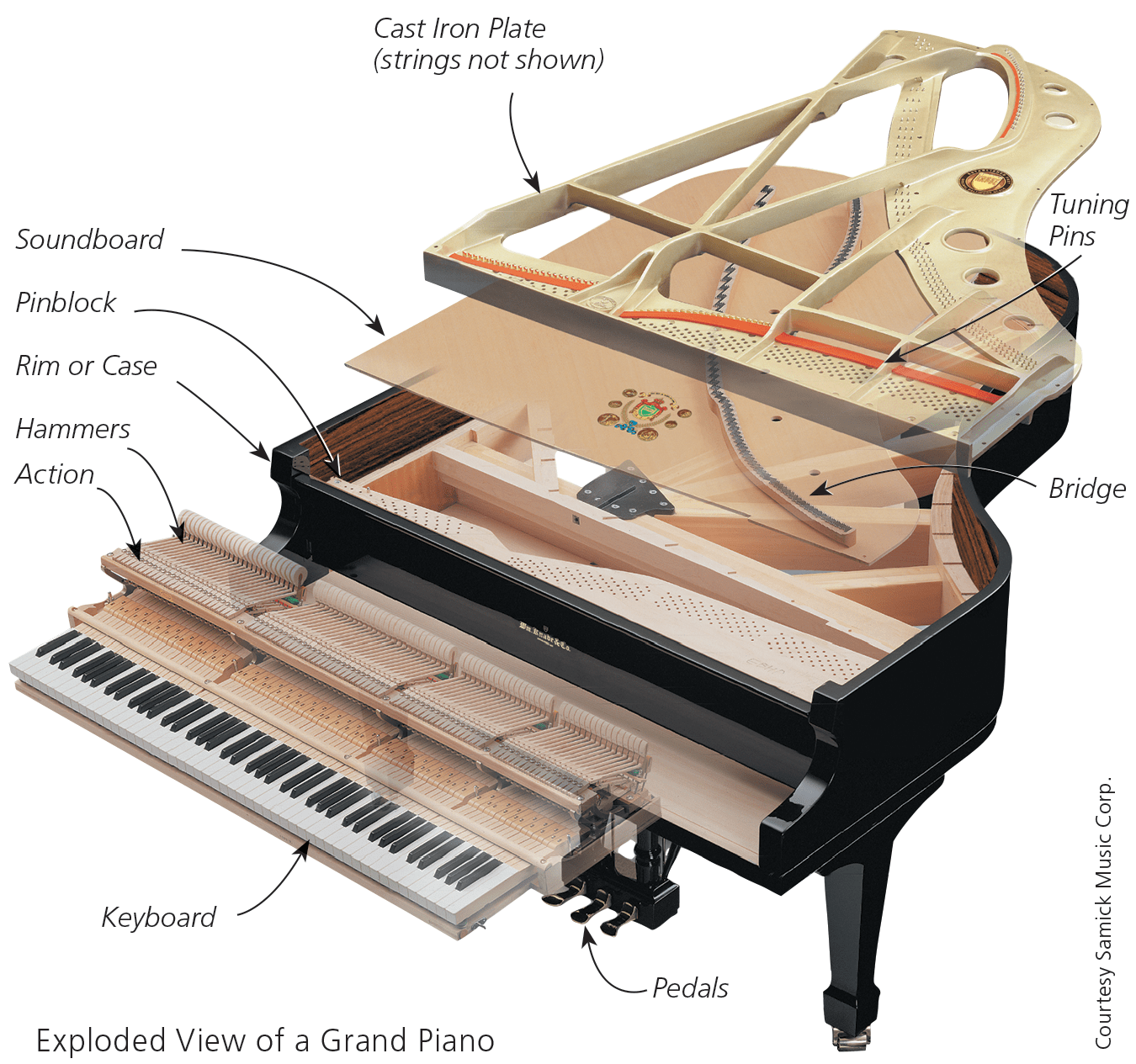A piano can be thought of as comprising four elements: mechanical, acoustical, structural, and cabinetry.

For the animation, click here.
Mechanical: When you press a piano key (usually 88 in number), the motion of your finger is transmitted through a series of levers and springs to a felt-covered wooden hammer that strikes the strings to set them vibrating. This complex system of keys, hammers, levers, and springs is known as the action. Also, when you press a key, a felt damper resting against each string lifts off, allowing the string to vibrate. When you let the key up, the damper returns to its resting place, stopping the string’s vibration. Pedals, usually three in number, are connected to the action and dampers via trapwork levers, and serve specialized functions such as sustaining and softening the sound. The right-foot pedal is called the damper or sustain pedal; it lifts all the dampers off all the strings, allowing the strings to ring sympathetically. The left-foot, soft pedal (on a grand piano, the una corda pedal) softens the sound. The function of the middle pedal varies depending on the type and price level of the piano (more on that later). As a sostenuto pedal, it selectively sustains notes or groups of notes, a function required only rarely in a small percentage of classical compositions. Other possible functions for the middle pedal include a damper pedal for the bass notes only, and a mute pedal that reduces the sound volume by about half.
Acoustical: Piano strings are made of steel wire for the higher-sounding notes (treble), and steel wire wrapped with copper for the lower-sounding notes (bass). They are graduated in thickness, length, and tension, and strung tightly across the structural framework of the piano. Each note has one, two, or three strings associated with it. Each such set of strings is known as a unison because all the strings in a set sound the same note. The strings lie across narrow hardwood bridges that transmit their vibrations to a wooden soundboard, usually made of spruce. The relatively large area of the soundboard amplifies what would otherwise be a rather weak sound and broadcasts the sound to the ears. The dimensions, arrangement, and positioning of all the acoustical elements in a piano is known as the piano’s scale design. The scale design varies with the model and is a major determinant of the piano’s tone.
Structural: The strings are strung across a gold- or bronze-colored plate (sometimes called a frame or harp) of cast iron, which is bolted to a substantial wooden framework. This heavy-duty structure is necessary to support the many tons of tension exerted by all the taut strings. A vertical, or upright, piano is one in which this structure stands vertically, and is most commonly placed against a wall. A grand piano is one in which this structure lies horizontally. In a vertical piano, the wooden framework consists of vertical back posts and connecting cross beams; in a grand, wooden beams and the familiar curved rim comprise the framework. One end of each string is anchored to the plate toward the rear of a grand or the bottom of a vertical piano. The other end is coiled around a tuning pin embedded in a laminated hardwood pinblock hidden under the plate at the front (grand) or top (vertical). A piano is tuned by turning each tuning pin with a special tool to make very slight adjustments in the tension of its string, and thus to the string’s frequency of vibration, or pitch.
Cabinetry: The piano’s cabinet (vertical) or case (grand) provides aesthetic beauty and some additional structural support. A grand piano’s rim is part of both the wooden structural framework and the case. Accessory parts, such as the music desk and lid, are both functional and aesthetic in purpose.
Although the acoustical and structural elements have been described separately, in fact the plate, wooden framework, soundboard, bridges, and strings form a single integrated unit called the strung back. A piano, then, consists of a strung back, an action, and a cabinet or case.

Previous Topic Next Topic